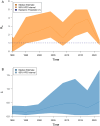Phylodynamics analysis of HIV epidemic history in Belarus in 1987-2022
- PMID: 40761738
- PMCID: PMC12318975
- DOI: 10.3389/fepid.2025.1601976
Phylodynamics analysis of HIV epidemic history in Belarus in 1987-2022
Abstract
This paper presents the first systematic molecular epidemiology study of the HIV epidemic in Belarus, an Eastern European country that, like much of Eastern Europe and including the Post-Soviet region, has been largely understudied in relation to HIV epidemics. HIV sequences collected nationwide between January 2018 and May 2022 were analyzed using phylogenetic and phylodynamic methods. The findings reveal two distinct epidemic waves spanning 1997-2005 and 2009-2018, each driven by different dominant modes of transmission. The study also identifies potential introductions and intra-country transmission routes, emphasizing the pivotal role of the capital city and eastern industrial hubs within Belarus in shaping the epidemic's trajectory. This work addresses an important gap in understanding HIV dynamics in Eastern Europe.
Keywords: Belarus; HIV; infectious diseases; molecular epidemiology; phylodynamics.
© 2025 Kirpich, Nemira, Adeniyi, Shishkin, Bunas, Kolomiets, Glinskaya, Gankin, Gasich and Skums.
Conflict of interest statement
The authors declare that the research was conducted in the absence of any commercial or financial relationships that could be construed as a potential conflict of interest.
Figures




Similar articles
-
HIV testing within general practices in Europe: a mixed-methods systematic review.BMC Public Health. 2018 Oct 22;18(1):1191. doi: 10.1186/s12889-018-6107-0. BMC Public Health. 2018. PMID: 30348140 Free PMC article.
-
Phylodynamics for Human Immunodeficiency Virus Prevention: A Miami-Dade County Case Study.J Infect Dis. 2025 Mar 17;231(3):643-652. doi: 10.1093/infdis/jiae605. J Infect Dis. 2025. PMID: 39688386
-
[Volume and health outcomes: evidence from systematic reviews and from evaluation of Italian hospital data].Epidemiol Prev. 2013 Mar-Jun;37(2-3 Suppl 2):1-100. Epidemiol Prev. 2013. PMID: 23851286 Italian.
-
A systematic review of post-migration acquisition of HIV among migrants from countries with generalised HIV epidemics living in Europe: mplications for effectively managing HIV prevention programmes and policy.BMC Public Health. 2015 Jun 19;15:561. doi: 10.1186/s12889-015-1852-9. BMC Public Health. 2015. PMID: 26085030 Free PMC article.
-
Antiretroviral therapy (ART) for treating HIV infection in ART-eligible pregnant women.Cochrane Database Syst Rev. 2010 Mar 17;2010(3):CD008440. doi: 10.1002/14651858.CD008440. Cochrane Database Syst Rev. 2010. PMID: 20238370 Free PMC article.
References
-
- unaidsorg. Data from: UNAIDS fact sheet (2024). Available online at: https://www.unaids.org/en/resources/fact-sheet (Accessed March 26, 2025).
-
- unaidsorg. Data from: UNAIDS 2023 report: chapter 1 (2023). Available online at: https://thepath.unaids.org/wp-content/themes/unaids2023/assets/files/202... (Accessed March 26, 2025).
-
- Carter A, Zhang M, Tram KH, Walters MK, Jahagirdar D, Brewer ED, et al. Content global, regional, and national burden of HIV/AIDS, 1990–2021, and forecasts to 2050, for 204 countries and territories: the Global Burden of Disease Study 2021. Lancet HIV. (2024) 11(12):e807–22. 10.1016/S2352-3018(24)00212-1 - DOI - PMC - PubMed
-
- unaidsorg. Data from: UNAIDS global AIDS update 2024 (2024). Available online at: https://www.unaids.org/sites/default/files/media_asset/2024-unaids-globa... (Accessed March 26, 2025).
-
- belstatgovby. Data from: Belarus population statistics–belstat.gov.by (2024). Available online at: https://www.belstat.gov.by/ofitsialnaya-statistika/solialnaya-sfera/nase... (Accessed March 26, 2025).
LinkOut - more resources
Full Text Sources
Miscellaneous

